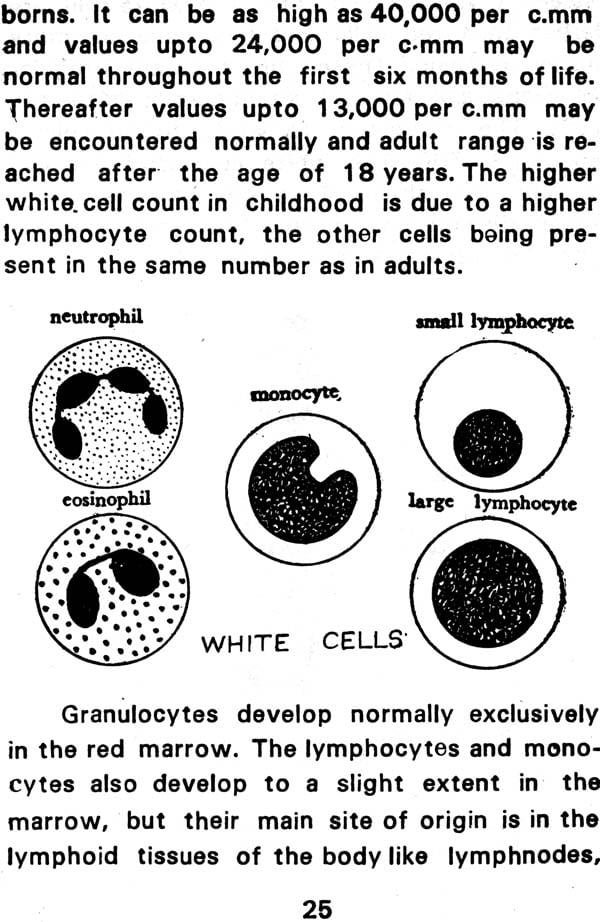
Blood
Book Specification
| Item Code: | NAK326 |
| Author: | Dr. U. Rama Rao |
| Publisher: | Balaji Publications Chennai |
| Language: | English |
| Edition: | 2003 |
| Pages: | 60 (18 B/W Illustrations) |
| Cover: | Paperback |
| Other Details | 7.0 inch X 4.5 inch |
| Weight | 50 gm |
Book Description
Whenever there is some medical problem, your family doctor asks for blood tests. You are curious to know what they are?
Dr. U. Rama Rao, a well known physician of Chennai city has written a number of medical books for the public. In this book, Blood, he has dealt with basic qualities of blood which are fascinating and also their usefulness in diagnosing diseases. An interesting book of those who want to know what the blood tests mean.
Blood, fourth book in "Balaji's Health Series", is being released with the blessings of Nandhikuru Shri Durga Parameshwari. When we are not well, we generally ask the doctor for "blood test". Is blood test the answer for diagnosing diseases? What is blood and its composition? How it is in a fluid state when inside the body and solidifies on coming out? What is blood trans- fusion and what is blood cancer? You will find answers for these questions in this book. But this book is not an elaborate thesis on blood. This is a simple book on the facts about blood and its uses in clinical medicine and will serve you as a reference guide.
I am greatly indebted to my respected father Dr. U. Srinivasa Rao and my respected Professor Dr. A. T. John. I appreciate the help rendered by my brother Dr. U. Krishna Rao, my mother Mrs. U. Radha Bai and my wife, Mrs. U. Gowri Rama Rao. My thanks are due to artist Sri A. Rajendran and typist Sri Dharmarajan. With much pleasure I remember the enthusiasm shown by late Sri K. Janakiraman of Balaji Publications. My special thanks to Mr. Visvanathan, present propriter of Balaji Publications for his continued support and enthusiasm. I thank Balaji Publications for their fine get up and Sri C.R. Krishnan for all the help rendered.
Blood is the vital fluid for our body and it is often referred to as "River of life". The universal distribution of blood in the body and its unique chemical characterestics make it a most efficient transport system.
It is red in colour, alkaline in reaction and salty in taste. Its specific gravity is 1.050 to 1 060. An adult has about 4 to 5 litres of blood• Blood is pumped by the heart into the arteries, supplied to body tissues through the capillaries and returned to heart through the veins.
Our vascular system measures about 60,000 tortuous miles and blood is able to traverse it within seconds with the help of heart's powerful pumping action. Because of blood's extreme importance to life, any injury to it or to the grand network of channels through which it flows, may have most serious consequences.
Though blood is in a fluid state inside the circulatory system, when it is exposed as in a cut injury, it becomes solid clot and there by efficiently preventing further bleeding. If this mechanism of clotting is not efficient, man will bleed to death as in certain blood coagulation disorders. If clotting tendency is more, blood clot can form as an embolus and as a complication of this man can have heart attack, stroke etc., depending on the vessel blocked.
Functions of Blood:
1. Metabolic function: Blood delivers nutrients to the tissues of all organs and carries the waste products away. Nutrients are absorbed into the blood from the small intestines and the waste products are eliminated from the blood through the excretory organs like kidney, lung etc.
2. Transport of oxygen: Blood delivers oxygen to the tissues of the organs and carries carbondioxide away. Oxygen enters the blood through the lungs and carbondioxide is eliminated through the lungs. Without oxygen, none of body's vital function can take place and all the living tissues will die if they are deprived of oxygen.
3. Transport of hormones: Hormones are carried by blood and these hormones either stimulate or inhibit the function of the various organs.
4. Protective function: Blood contains cells which have the properties of phagocytosis and special antibodies which play a protective roll in the defence mechanism of the body.
The amount and composition of blood in a healthy person are relatively constant; they are subject to slight variations depending on the external conditions of the individual, but quickly return to normal. Various diseases 'cause considerable changes in the blood end the character of these changes may help in diagnosing the disease. These we will look into in the following chapters. If all the tissues of the body are to function normally, the amount and composition of the blood must be relatively constant.
Certain amount of blood is not in circulation execpt in certain conditions like excessive muscular work or sudden blood loss. This hidden blood is stored in blood depots like capillaries of the spleen, liver and subcutaneous tissue.
| 1 | Introduction | 5 |
| 2 | Composition and Formation of blood | 9 |
| 3 | Red blood cells | 15 |
| 4 | White blood cells | 24 |
| 5 | Platelets | 33 |
| 6 | Plasma | 35 |
| 7 | Heamostasis (Blood clotting) | 37 |
| 8 | Blood groups | 41 |
| 9 | Blood translation | 46 |
| 10 | Blood cancer | 49 |
| 11 | Blood tests | 53 |
| 12 | Important normal blood values | 57 |






